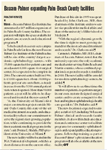Article
Modified prolate anterior surface IOL improves acuity
New Orleans—The modified prolate anterior surface IOL (Tecnis, AMO) is creating a new standard for visual performance after cataract surgery, according to Robert M. Kershner, MD, MS, FACS, at the Spotlight on Cataracts 2004: Cataract Controversies Symposium, held during the joint meeting of the American Academy of Ophthalmology and European Society of Ophthalmology.

"While there have been some tremendous advances in IOL technology over the past decade, until very recently little attention has been placed on changing the IOL optic from the original spherical design introduced by Harold Ridley 55 years ago," Dr. Kershner said.
"With its modified prolate anterior surface optic that neutralizes the spherical aberration of the average older cornea, the Tecnis IOL has been documented to provide patients with improved contrast sensitivity and better functional visual performance, particularly for tasks performed in dim light conditions," Dr. Kershner added. He is clinical professor of ophthalmology, John A. Moran Eye Center, University of Utah School of Medicine, Salt Lake City; director emeritus of Cataract and Refractive Surgery and Anterior Segment Fellowship Program, Eye Laser Center Tucson, AZ; and has a Boston-based private consulting firm for ophthalmic medical device, biomedical, and biotechnology development.
"Postop refractive errors were similar in all groups," Dr. Kershner said. "The association between the Tecnis IOL and better uncorrected vision was surprising to me because we have become so accustomed to achieving rapid return to excellent uncorrected vision in our contemporary cataract surgery.
"However, the reason why the Tecnis IOL seems to perform even better is that it improves contrast and so works particularly well in the situation of high-contrast testing using the Snellen acuity chart," Dr. Kershner observed.

In contrast, the spherical acrylic IOL had no effect on photopic vision contrast and was generally associated with lesser increases than the Tecnis IOL in the other tests, while no improvement from preoperatively was noted in contrast testing in eyes with the spherical silicone IOL implanted.
Dr. Kershner further evaluated the visual performance of the three IOLs using digital analysis of images from fundus photography. Those studies showed improvement in clarity of the image with all three IOLs when comparing the preoperative and post-cataract surgery results. However, only the Tecnis IOL was associated with increased contrast as well.
"So the images we are seeing of the fundus through the Tecnis IOL are substantially better compared with those seen in eyes with conventional spherical IOLs implanted," Dr. Kershner said.
Nighttime driving simulation studies show the differences associated with the Tecnis IOL translate into benefits for improved functional vision performance, and that is recognized in its labeling. Relative to a control group with a conventional acrylic IOL implanted, older patients with the Tecnis IOL identified a pedestrian target more than 0.5 seconds earlier. When traveling at 55 mph, that time difference allows for a 45-foot stopping distance advantage, noted Dr. Kershner.
Newsletter
Don’t miss out—get Ophthalmology Times updates on the latest clinical advancements and expert interviews, straight to your inbox.





